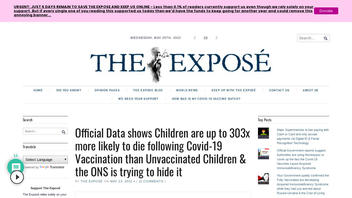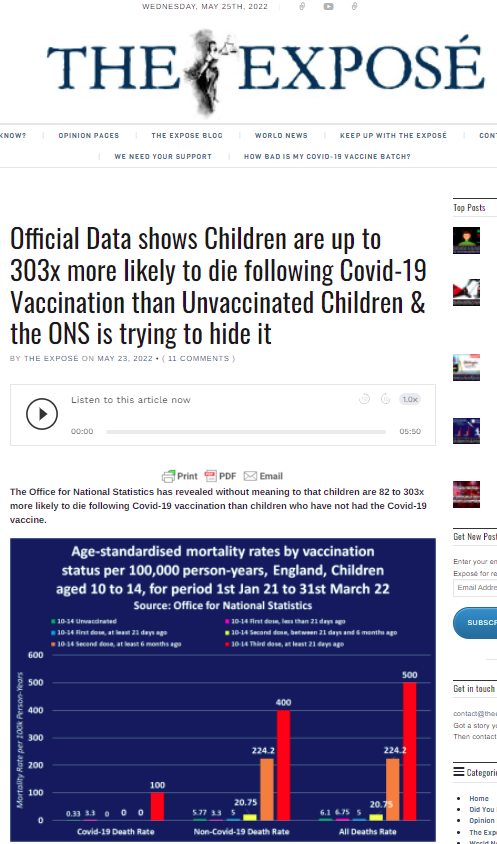
Does data from England show children are up to 303 times more likely to die from COVID-19 following vaccination than unvaccinated children? Yes, that's true, but raw numbers don't tell the full story.
"The numbers appear correct, but ... are highly misleading. Mortality rates should be interpreted carefully for children because of the way children at risk were prioritised in the vaccine roll out," the Office for National Statistics (ONS) told Lead Stories. "The article makes it sound like the differences can be attributed to the vaccine. However, early on in the vaccination campaign, the children who were vaccinated could not be compared with the children who were not, because only children with severe illnesses were vaccinated."
The claim appeared in an article (archived here) published by The Exposé on May 23, 2022, under the title "Official Data shows Children are up to 303x more likely to die following Covid-19 Vaccination than Unvaccinated Children & the ONS is trying to hide it." It opened:
The Office for National Statistics has revealed without meaning to that children are 82 to 303x more likely to die following Covid-19 vaccination than children who have not had the Covid-19 vaccine.
This is how the post appeared at the time of writing:
(Source: The Exposé screenshot taken on Wed May 25 15:31:49 2022 UTC)
The data from the ONS cited in the article covers the period from January 1, 2022, through March 31, 2022. The Pfizer vaccine in England only became available for some 12- to 17-year-olds in July 2022 and for some 5- to 11-year-olds in February 2022.
In a May 25, 2022, email to Lead Stories, the ONS urged caution in reading too much into the early numbers, especially for the youngest group receiving COVID vaccines:
Mortality rates should be interpreted carefully for children because of the way children at risk were prioritised in the vaccine roll out. It is also worth noting relatively few children would have been triple vaccinated at the time of our latest study and some of these age categories have relatively few deaths, so rates vary considerably.
Clinically vulnerable children and young people have a higher mortality rates than those with no comorbidities, and this explains why vaccinated children have higher rate of death than those who remained unvaccinated.
In the same email, ONS said we can gain insight by looking at teens who have been receiving the vaccine longer:
- To get around the low number of deaths we can compare all vaccinated to unvaccinated. In which case, for 15-19 year olds, the unvaccinated crude mortality rate is 0.15 per 1000 and the vaccinated is 0.16 per 1000, so not really very different.
- The difference is larger for the 10-14 year olds (0.06 per 1000 unvaccinated, 0.09 per 1000 vaccinated) as they were vaccinated later so there is still a larger difference in the proportion who are clinically vulnerable in the vaccinated and unvaccinated groups. We'd expect this to reduce over time as more 10-14 year olds are vaccinated and have contributed more person years to the vaccinated states.













